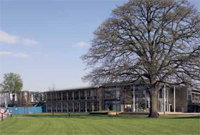Nicky Mulder, bioinformatician Inspire article
Have you ever wondered what bioinformatics is? Or what a bioinformatician does? Sai Pathmanathan and Eleanor Hayes talk to Nicky Mulder, a bioinformatician at the European Bioinformatics Institute in Cambridge, UK.

Image courtesy of
EMBL Photolab
Recent advances in molecular biology mean that we can now analyse DNA sequences easily and quickly, performing – in a matter of days – analyses that, not so long ago, would have taken years to carry out. The result is an explosion in the amount of biological data available, but data alone do not confer knowledge: we need ways to interpret it. That is precisely the purpose of bioinformatics: the application of computer technology to the management and analysis of biological data.
That may not sound very exciting, but bioinformatics is in fact an important and interdisciplinary research area at the interface of the biological and computational sciences. The ultimate goal of bioinformatics is to uncover the wealth of biological information hidden in the mass of data, to help us understand the fundamental biology of organisms and to use this information to benefit humankind. The results of bioinformatics research could assist fields as varied as human health, agriculture, environmental protection, energy technology and biotechnology.
In molecular medicine, bioinformatics is already used to produce better and more customised medicines. In the field of environmental science, it is used to identify bacteria that are capable of cleaning up polluted areas (bio-remediation) and in agriculture it can be used to develop high-yield, low-maintenance crops. These are just a few of the many benefits of bioinformatics, now and in the future.
But surely Nicky didn’t know all that when she was at school in South Africa? Of course not! In fact, she had planned to become a graphic designer, but always enjoyed science, even though she didn’t study biology at school. “Towards the end of my final year, our school guidance counsellor told me about the Bachelor of Science at university,” says Nicky, “and all the subjects sounded so interesting that I decided to do it!” She specialised in microbiology and chemistry and then went on to do a PhD in medical microbiology.

Image courtesy of EMBL Photolab
So how did she get involved in bioinformatics? “During my PhD, after doing lots of bench work [experiments], I had to do some data analysis on the computer. I found this part interesting and was amazed to see how much you can find out about a gene through computational tools.” This technological side of the biological sciences had grabbed Nicky’s attention. Following her PhD she dived straight in and began work at the European Bioinformatics Institute (EBI) in Cambridge, UK. One advantage for Nicky was the lack of laboratory work, because she was uncomfortable experimenting on animals.
Nicky’s job has two different aspects. One involves providing a database and computational tools to scientists all over the world. It is a real challenge to keep up with user demands but it proves to be greatly rewarding too. “So many people access, use and quote the resource from all over the world for their research.” The second part of her job involves infectious diseases. Nicky is currently using computational tools to analyse the genome sequences of pathogens such as Mycobacterium tuberculosis (the bacterium that causes tuberculosis) to better understand how the pathogens work. “We still do not know the function of so many genes in this organism, but among them there may be some that are important in causing the disease and therefore have potential applications in drug or vaccine design.”
By comparing the sequence of ‘unknown’ genes with the sequence of genes in other organisms for which the function is already known, bioinformaticians can gather information about the possible function of genes. This method is known as comparative genomics. The data come from public databases that store genome sequence information; Nicky and her colleagues take these data and perform their own data manipulations and comparisons to try and make biological sense of it. “So far we have found that some genes that are known to cause disease in other pathogens can also be found in M. tuberculosis, so we can investigate these further. We have also found some genes that are unique to M. tuberculosis that may be required for its survival in the host, and we can now study these further in collaboration with colleagues in the laboratory.”
Nicky finds science exciting, as it deals with important problems. “For everything I do, I can see a real-life example or application of my work, so my results have the potential to affect other people and potentially help in the medical field.” What about the drawbacks? “There is constant pressure to publish results, and scientists often compete rather than collaborate. You can work on a problem for ages only to find suddenly that someone else has published it before you!”
Are there other challenges? “The challenges are mostly in keeping up to date with the current literature and finding an appropriate research post,” says Nicky. “Another challenge is the constant need to find funding for research.”
Being promoted to team leader at the EBI was a particularly memorable moment in Nicky’s career. “I had been running a project at the EBI for a few years but didn’t officially receive credit for it until I was promoted to team leader of the project.” She is now responsible for day-to-day management of the team as well as for strategic decision-making on the direction and goals of the project. “It has also been rewarding for me as a woman, as the majority of team and group leaders at the institute are male. I hope this encourages other women in science to be ambitious.”
We asked Nicky what advice she would give to someone who wants to do bioinformatics. “Try to get a good basic grounding in both biology and computer science, then apply for a position or studentship in the field – the best way to learn is on the job.” Nicky is keen to encourage young people to think about a career in science, and has visited several schools to speak about career opportunities in bioinformatics.
In the future, Nicky would like to focus a bit more on research. “Until now, my main responsibilities have been to keep the database and service running efficiently for the public. I would like to have time to use all the important data we store and generate, to answer interesting biological questions such as those in our research project on M. tuberculosis.”
Resources
- The European Bioinformatics Institute provides a range of teaching materials in bioinformatics, including a DNA code-cracking quiz. You can also try translating your name into DNA code and searching for proteins with your name in them! See www.ebi.ac.uk/training/schools/
- The EBI also hosts the 2CAN portal, which introduces bioinformatics and demonstrates how to perform bioinformatics analyses using EBI tools: www.ebi.ac.uk/2can/
- The EBI, as part of the European Molecular Biology Laboratory, offers workshops for teachers at the European Learning Laboratory for the Life Sciences: www.embl.org/ells/





